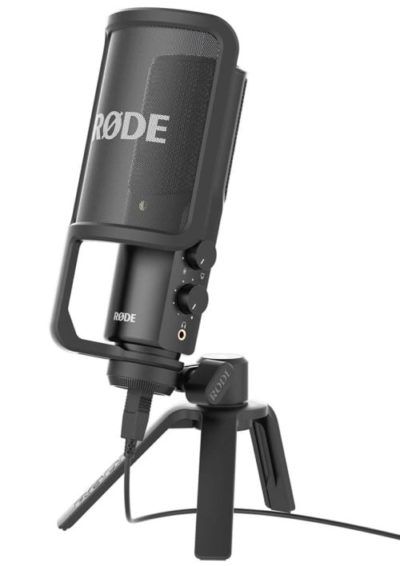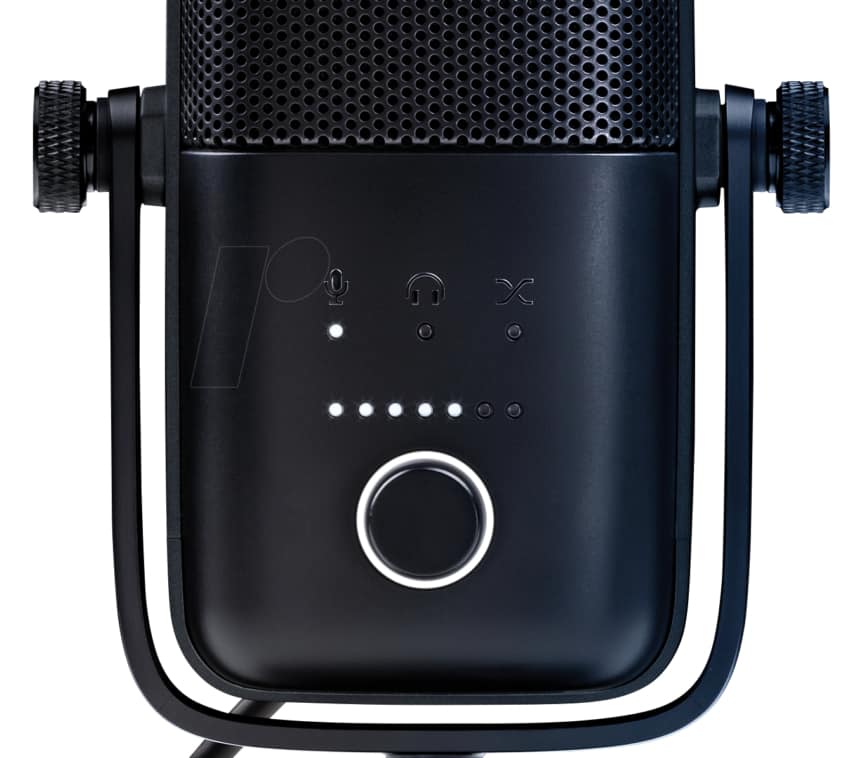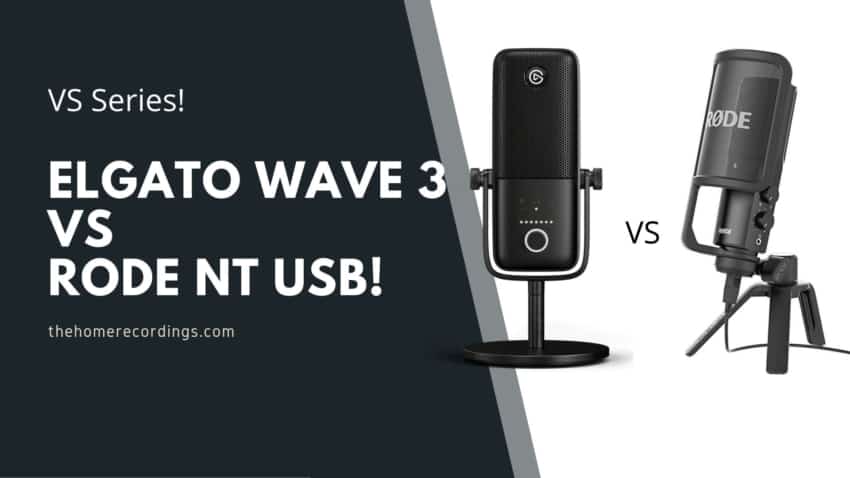Last updated on December 29th, 2023 at 09:57 pm
The Rode NT USB is a fairly well-known USB microphone that often gets compared to the Audio-Technica AT2020 USB and the Blue Yeti, and while it may be a pretty darn good microphone, I think that there might be a better alternative for you, especially if you’re a gamer or streamer.
This is why I decided to compare it to the Wave 3 by ElGato, since I think that it’sthe absolute best gaming microphone currently available.
So, without any further ado, let’s get into the article!
Rode NT USB and ElGato Wave 3 differences
The Rode NT USB has a better build quality since it’s made entirely out of metal and it also comes with a pop shield. However, it only comes with mix- and headphone volume controls. The ElGato Wave 3, in addition to the mix and headphone volume controls, features a gain knob, and it also comes with the Wavelink software, the Clipguard and a High-pass filter.
I will be giving you a complete overview of how the Wavelink software works later on as well as demonstrating how the Clipguard can help you avoid distorting your audio, which is why the ElGato 3 is the absolute best gaming & streaming microphone currently available.
Let’s get started with the Rode NT USB.
Rode NT USB

The Rode NT USB is an excellent Condenser USB cardioid microphone.
Rode is known for making extremely high-quality equipment at reasonable prices, and the Rode NT USB is no exception to this rule.
It comes with a pop filter, which is extremely good, a tripod desk stand, a ring mount, and a storage pouch.
The two controls on the side are for the headphone volume, which comes in handy when you want to do zero latency monitoring, and the Direct mix control between mic input and source output.
This means that you can choose to hear only what’s coming out of the PC, or to only hear the direct signal from the Mic, or a blend of those two.
Now, you might have noticed that it doesn’t come with a Gain dial, which for a mic in this price-range is just ludicrous.
You can control the levels from your PC however, but this isn’t ideal.
This microphone is pretty good for recording singing and spoken word applications such as podcasting and voice-over.
When looking at the build quality I have to say that it’s just great.
It’s got some weight to it and it doesn’t feel at all flimsy or delicate.
Like I mentioned, it includes a pop filter which is rare since most microphones don’t include one, and even though it feels a bit cheap, it’s still a free pop filter that works.
Lastly, it works on Windows and Mac OS based computers, as well as the Apple iPad.
How does it perform?
To be honest, I wasn’t as surprised as I thought I would be when trying out this mic.
For spoken word applications or for quiet singing it works super well, however when recording instruments that are a bit too loud, or any other loud sound source for that matter, even if the signal doesn’t clip, it will sound as if it’s clipping.
Also, having no Gain dial makes it a bit of a pain to set the levels correctly…
Other than that, I think that the Rode NT USB does a pretty decent job at doing what it’s supposed to do, just remember to not record very hot signals.
Now, there is one important thing to consider when thinking about getting the Rode NT USB, since it literally costs twice as much in certain European countries than in the US.
I have seen it in the Amazon Store in Germany for almost the same as in the US, but in Spain, and other countries, it sells for twice as much.
In this case, you could actually purchase an Audient iD14, which is an insanely good Audio Interface, plus an XLR microphone and have a much better setup for the same money.
What comes in the box?
- The Rode NT USB Microphone
- Pop Filter
- Microphone Stand
- Microphone Mount
- Storage Pouch
Features
- Polar Pattern: Cardioid
- Pop shield, Tripod desk stand, ring mount, storage pouch and 6m (20’) USB cable included
- Includes Headphone Jack
- Frequency Response: 20Hz -20KHz
- Sample Rate: 48KHz/16-bit
Specifications
- Polar Pattern; Cardioid
- Frequency Response: 20Hz- 20kHz
- Sample Rate: 48kHz/16-bit
- Max SPL: 110dB
- Weight: 520g
Find out more about the Rode NT USB here.
- Rode NT USB: Amazon, Sweetwater.
Elgato Wave 3

Now, I have to say that I didn’t have high expectations for this mic at all, but I definitely was impressed since for once a company decided to focus on what the users actually need, instead of just adding unnecessary features to inflate the price.
So, if you’re a gamer, YouTuber, Streamer, etc., this microphones probably has everything you need.
As far as the build quality goes, it’s nothing to brag about since the body is made out of plastic which does feel a little cheap, and the U-bracket that attaches the mic to the desk-stand is also made of plastic.
The mesh grille is metal, but it has a bit of give to it, which isn’t ideal as well.
Even though it should last you a very long time if taken good care of, the overall build quality is lacking, and I wouldn’t recommend dropping this mic or anything similar.
However, and even despite this, I still think that it’s probably the best microphone for Gamers/YouTubers out there, and here are the reasons for that:
- It features a “Clipguard”, which when enabled will prevent clipping or saturation if you signal gets too loud; like for example if you scream.
- It also comes with a high-pass filter that can be enabled to remove a bit of the low end, and this can come in handy when you want to better deal with the proximity effect (basically, the closer you get to the mic, the more low-end you will hear, and the high-pass filter helps deal with this).
These features can be accessed through the Wave Link software that comes with the mic and are definitely something that the gaming and streaming community desperately need to be able to produce content with good sound quality, and it’s refreshing to see that a company has finally taken notice.

Lastly, it features a Mute button, gain control, headphone volume, and the mix control between the computer’s playback and zero-latency monitoring.
Note: If you want to check out my full written review of the ElGato Wave 3, you can find it here.
How does it perform?
As far as spoken word goes, which is what this mic was mainly designed for, it’s absolutely great since there are no prominent frequencies poking there head out anywhere, plus if you want to get rid of some of the low end, you can always engage the high pass filter.
The Clip Guard is definitely a huge plus here, since there will be no more clipping/distorting, which is definitely something that streamers have to del with on a daily basis.
There is one issue though, and it’s that the desk stand doesn’t really help reject any noise coming from the desk itself, like for example if you tap your fingers on it, the vibration coming from the keyboard, or basically bumping against the desk.
In that case, I would much rather recommend a boom arm with a shock mount to absorb those vibrations.
Now, what if you want to record music with it?
Well, for singing it does more than fine!
As far as recording instruments go, it did a decent job at recording acoustic guitar, and the HPF came in handy here since it allowed me to angle it more towards the sound hole and still get a good recording.
Also, I have to say that I was pleasantly surprised at how well it managed to capture the sound of my electric guitar cabinet, even with distortion.
Still, I think that I would much rather use a good dynamic mic for this, but hey… it works!
Finally, the Wave Link software that comes with this microphone is where you can enable the Clip Guard and the High Pass filter, plus it lets you mix the audio signals from different sources in the PC, like Google Chrome, etc. and decide how high or low the volume of every source will be on the stream.
What comes in the Box?
- Elgato Wave 3 Microphone
- USB Cable
- Mic Stand adapter
Features
- ClipGuard
- High Pass Filter
- Mute Button
- Wave Link Software for more in-depth control of the audio
Specifications
- Polar Pattern; Cardioid
- Frequency Response: 20Hz- 20kHz
- Sample Rate: 48kHz/96kHz – 24-bit
- Max SPL: 120dB
- Sensitivity: -25dBFS
- Weight: 280g
Which one is right for you?
In all honesty, unless you want a microphone that is built like an absolute tank, I would have to say that the ElGato is the better choice simply because it sounds just as good, if not better as the Rode NT USB, and it doesn’t suffer from the “High gain” issue I mentioned earlier.
Plus, not having a Gain knob is just silly…
Additionally, the Clipguard is an absolute life saver for most gamers since it will prevent unnecessary volume spikes and audio distortion.
If I had to choose between one of the two, I’d go with the ElGato Wave 3, no questions asked.
Conclusion
I just mentioned that I’d much rather have the ElGato wave 3 over the Rode NT USB, even though the Rode might be MUCH better built, but the audio quality of the ElGato is fantastic, and the additional features can’t be ignored, especially if you’re a streamer or gamer.
I hope this information was useful!
Have a wonderful day!

Thanks this was really useful